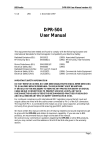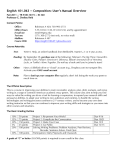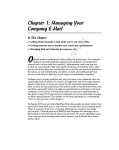Download English - Gato Audio
Transcript
by Huang Hanxuan An ingenious piece of exquisite sound essay Output power: 150W X 2 (8Ω) 250W X 2 (4Ω) Input impedance: 20kΩ (RCA) 40kΩ (balanced) Frequency response: 20Hz-20mz (± 0.5dB) Preliminary output impedance: 100Ω (RCA) 200Ω (balanced) Total harmonic distortion: less than 0.05% (within rated power) Signal-to-noise ratio: greater than 100dB Voltage gain: 27dB Dimensions: W 325 X H 100 X D 430 (mm) Weight: 13.8 kg Sales Rep.: YUAN Qing 02-2365-6706 Denmark is located in Northern Europe, with a land area slightly larger than that of Taiwan, and a population of only just over five million, but this small country boasts of a number of world leading audio brands. Founded in 2007, Gato Audio recently introduced its Danish brand into Taiwan. With a history of three to four years, it has already acquired a comprehensive product line, including signal sources, amplifiers and speakers which are all readily available. In addition, there are also offerings of wiring materials and other peripheral products. A relatively new brand as Gato Audio is, there are four peoplein-charge behind the brand: Poul Rossing, Frederik Johansen, Kresten Dinesen and Rasmus Holm, all of whom have quite a profound professional background and have worked for Avance, Holfi, Thule, GamuT and other well-known audio companies. Diversified and Profound High-end Qualifications Gato Audios spiritual leader, Poul Rossing, has been involved in the audio profession for years, dating back as early as the 1950’s. In the mid-twentieth century, Poul Rossing’s father began to produce radio sets with his own company. Poul Rossing worked for his father and learned many different audio technologies, including vacuum tube amplifiers, speakers production, etc., and at the same time developed considerable experience in business management. During the 1960’s and 1970’s, when HiFi sound started to take off, Poul Rossing became an importer and introduced a series of advanced audio brands in to Denmark, including B & W, Audio Research, Cabasse, Luxman, etc. These brands have now all become leaders in the highend market. In 1973, Rossing Electronic launched a series of speakers under the brand Avance, and this brand became one of the first well-known advanced speaker brands in Denmark. Later, Rossing Electronic sold the Avance brand to its Chinese partner, and now it is marketed as “Danish Crown” in China. The two other key figures, Frederik Johansen and Kresten Dinesen, used to be colleagues in the small Danish highend factory of Holfi, and worked respectively in production management and product development. In 2001, Frederik Johansen, equipped with a manager’s expertise, transferred to another high-end manufacturer Thule Audio, and was responsible for product management, logistics, human resources and other functions. In 2003 Poul Rossing took over the Danish veteran brand GamuT by share transaction. Soon afterwards, Frederik Johansen and Kresten Dinesen began to work for GamuT, and has interacted with Poul Rossing ever since. In 2006, Poul Rossing sold out the brand of GamuT, and then worked with Frederik Johansen, Kresten Dinesen and another engineer, Rasmus Holm, to create the new brand - Gato Audio. From this historical view, Gato Audio is young and not yet well known, but the entrepreneurial team boasts of very strong qualifications in the high-end audio circles. Four central figures have professional experiences that cover business, management, development and production that other different aspects and they all have their own strengths. Therefore Gato Audio has, in just three or four years from being established, acquired a complete product line and opened up cross-border, cross-continental overseas markets, thus becoming a new generation of international brands. Innovative and Remarkable Design Elements This audition model Gato Audio AMP-150 Integrated Amplifier is currently the only amplifier product of Gato Audio, positioning at the high price end, and can be defined as the result of the manufacturers’ careful efforts. After understanding Gato Audio’s brand origins, we should take a look at AMP-150’s appearance, which is easily mistaken for a piece of Italian equipment. The AMP-150 uses stainless steel, aluminum, wood and multiple other materials so as to create a compact-sized, beautifully-curvy enclosure, leaving a deep impression. The display in the middle of the panel and knobs on both sides show the process beauty of simplicity and neatness, reminiscent of an F1 car. The upper cover is made of MDF plate printed with a brand logo, and comes in a variety of veneers and colors. Both fuselages are flanged with heat sinks made of thick aluminum. Common heat sinks are generally fin-shaped. Although the cooling efficiency is good, they are not always a thing of beauty. Gato Audio ingenuously shapes the heat sinks like a smooth arc, thus naturally integrating into the streamlined body and becoming an integral part of the whole design. The design in the operation of the panel is very interesting. The display in the middle is simultaneously responsible for displaying the volume levels, input signal sources, and the unit condition. The pointer indicates the current volume setting; the turn of the right knob adjusts the volume accordingly. After the poweroff, the pointer will automatically turn counterclockwise to zero at the bottom left corner. Interestingly, after rebooting, the pointer will instantly turn clockwise back to the original volume level and restores the volume setting before the power-off. The very design in volume control shows that Gato Audio sells some pleasing new ideas. Best Quality Product The input signal source is indicated by LEDs on the front panel. The indicator light of the balance input is designed like a scale, the CD is like a shining sun, and the LP looks like a round circuit. The remaining space of the enclosure is covered with printed circuit boards, making full use of three-dimensional space and closely and neatly squeezes the various electrical board sheets, large and small, into a small chassis. Both left and right channels each have a row of transistors, neatly arranged on both sides of the chassis. Although the machine has a rated power of only 150 watts and not Class-A amplification, but as the content shows, it leaves considerable free space for either the input of materials or design efforts. The two white-enclosure main filter capacitors look like an 180cc coffee can, firmly fixed under a sheet of metal; guessing from the exposed part, it should be an advanced electrolytic capacitor by RIFA. All the rest of the capacitors on the circuit board are ROE or Panasonic. According to the instructions in the user manual, the AMP-150 will reach Like an accurate and precise conductor, the AMP-150 is clear-cut and never vague about how each musical instrument each and every musician should perform, and the opening and closing, ups and downs, strength and weakness of the music. disc, realizing an interesting and intuitive sense of design. In addition to volume control and switching between signal sources, there are two additional functions, one is the bypass volume controller -- the volume attenuation is done by the front-end equipment. If the front-end equipment has already been equipped with the volume controller, then there will be one level less of volume control in the integrated amplifier and the sound will be more transparent and purer. After the option of the bypass volume control is enabled, the Direct LED at the lower right corner of the display will light up. But the panel has no bypass-mode switch; the bypass mode has to be turned on by a complex operation. Switch the input signal source to the cassette and then press the mute button for two seconds to enter the bypass mode. Another feature which is even more interesting is called “Heat”. There is a Heat button on the panel, and if the button is pressed after booting, the machine will warm up more quickly. The transformer, on the other hand, is also a product from a well-known Scandinavian transformer factory, Noratel’s “Dragonfly”. In addition to the main transformer, there is also a small transformer located at the side which should be the power supply of the control optimal operating temperature after two hours of pre-heating, and after pressing the Heat button, the time of pre-heating is shortened to 10 to 15 minutes, which is very interesting. In the heating process, the Heat LED will light up at the lower left corner of the panel, and after the temperature stabilizes, the Heat mode will automatically shut down, and the corresponding lights will turn off. For many busy music enthusiasts, the time spent in listening to music is only two or three hours in a day. Therefore, it will be too late to wait for the machine to preheat for the realization of real good music. The rapid warm-up mechanism solution of Gato Audio MP-150 considerately addresses this concern of music enthusiasts. The back panel of the AMP-150 has rich output/input interfaces, and has five input sets, including CD, LP, tuner, cassette and balanced input. The output provides one set each of singleended and balanced output. In other words, the machine can be used as the primary equipment. Test Results of GATO AMP-150 I II III Figure I is the FFT spectrum analysis chart of the machine outputting a 1kHz sine wave 35W/8Ω signal. The figure shows the third harmonic of about 200nW, generating the powered harmonics and high-order harmonic, and the distortion reading is 0.015%. Figure II shows the frequency response curves of the machine at 0.1W, 1W, 10W and 100W, and the low-frequency response at 20Hz should have a little attenuation, and the high frequency response can be extended to 200kHz (- 3dB). Figure III is the plot chart of the machine’s output power versus distortion, and the maximum power of the non-cutting waveform is 117.3W, and the power for THD + N at 10% is 154W. (Guan Peiqing) Figure 1: The huge toroidal transformer with abundant power supply, which can be seen to be manufactured by Noratel. Figure 2: The filter capacitor is fixed with screws on the thick solid copper bar to reduce the internal resistance of the power supply. Figure 3: The volume control is addressed by the high-performance volume control chip. Figure 4: The power amplifier circuit for each channel applies a pair of high-power circuit transistors. Figure 5: Front-end circuit concentrated in the backplane position closest to the input terminal. Selectiveness with Materials and Considerate Layout Remove the front panel and take out the upper cover, made of MDF; you are faced with a beautiful, compact interior. About half of the enclosure space is loaded with no small amount of high-end products using Ring and other famous brands, which are often used by music fans as complementary materials for remodeling. Gato Audio installs the complementary parts into the machine in advance, and compared with the European and American machines in the same price range, the selection of such high-level materials offers remarkable sincerity. Delightful and Extraordinary Musical Performance The audition model Gato Audio AMP-150 works best with an excellent standing speaker, the Adam Classic Pencil MK3, and the classic CD player Krell KPS-30i, the permanent resident in this issue. After the replacement of several groups of wiring and testing different speaker terminal connections, we find a balance point before starting the audition. The first play trial is a rock band U2’s album “Achtung Baby”. As Gato Audio is a new brand, the author had no pre-established setting of the AMP-150’s sound and participated in the audition with a fresh perspective. This amplifier gives the author a first impression of being skinny, ethereal, and flying freely between elastic and tension. For rock-and-roll music, AMP-150 is especially capable of grasping just the right rhythm, a rhythm filled with tension. The next audition participant is Mozart’s clarinet trio, a chamber composition of small preparation consisting of the clarinet, piano and cello. The clarinet sounds very mellow, elegant and shows its dignified side. The cooperation of the three co-performers sounds like it is being blessed with a certain degree of heat and tension, mild but not cold, and all the details, strengths and tones are in perfect control, with no unexpected caprice or anomaly. At the same time seems to lack a little naturalness or ease; it is just does not flow smoothly enough. Then here is another rock-and-roll album, REM band’s “Reckoning”. In this system, the tones appear to be unhurried, neat, orderly and moderate. The AMP-150 is like a precise and accurate conductor and clear-cut and never vague about how every piece of instrument and each and every musician performs and the ups and downs, the weakness and strength of the music, especially the low-frequency control. Although the machine has a rated power of 150 watts, not a so-called monster machine, the Bass and the drum sound unusually strong, relaxed and rapidly tightened, both crisp and tight. Upon hearing the song Tighten Up, details can still be displayed clearly and carefully in lively and colorful music, and every kind of musical instrument has their own different textures, with rich in details and highly recognizable tones. The micro-state dynamic and transient performance is also excellent. Even in the craziest, most “released” music section, the music will still retain its order and perfect control. Precise Details and Overwhelming Style Let’s listen to the classic jazz master Hoagy Carmichael’s singing selection “Hoagy Sings Carmichael”. Hoagy’s voice has so many delicate details. Whether it is gas or lips-and-teeth sounds, or various small turning and emotional expressions, they have all been deeply excavated. The author also found out that AMP-150’s personality, though not famous for its hyper trophyness and abundance, the thickness and density of the human voice is still quite impressive. The trumpet’s tone and sense of glossy is self-evident. This precise, just right sound interpretation is indeed one of the most outstanding qualities of the AMP-150. Finally, let’s listen to the great classical music album prepared by master composer, Pierre Boulez, conducting the Vienna Philharmonic’s Bruckner Eighth Symphony. This live recording is quite excellent in itself, very dynamic, thus becoming an exciting record of the concert momentum. In the loud ensemble of the fourth movement, the AMP-150 truly vividly reproduced the kind of power and the overwhelming force of an army marching and the splendid soldier’s discipline, bringing about exultant listening experiences. The only pity is that, relative to the strong strength, the AMP-150 seems a bit “skinny” in terms of the fullness and richness of the sound. It is just like a swimmer with a fit body and fine bone structure, but his muscle seems too lean, of course it is just the subjective feelings of the nitpicky author. In this Bruckner song, there are many turns from the weak to the strong and gradually from the strong to the weak. With the perfect mastery of this amplifier, these turns are manifested in a structured manner with extremely high accuracy. And with the exact layout, the overwhelming momentum by the climax section at the end of the chapter appears even more extraordinary until it is equipped with the regency charm. Conclusion The Gato Audio AMP-150 is a very uniquely integrated amplifier. Regardless of appearance, design, workmanship or sound, manufacturers are showing dedication and effort in every aspect. As for the sound performance, the AMP150 has outstanding control ability; the expression of music is especially precise and detailed. With the full exertion of strength and skinny, ethereal tone, it is neither masculine nor feminine, displaying vigorous and graceful beauty. All music is performed flawlessly and meticulously, so much that sometimes I think maybe a moment of out-of-control will bring about a special flavor and charm, but the AMP-150’s seriousness and carefulness when playing music will explain all the nuances clearly, without missing any small section. From this attitude we can feel an extreme sincerity of heart. It is this very sincerity that makes music touch our hearts, and that is also exactly where the Gato Audio AMP-150’s charm of the music lies!




























